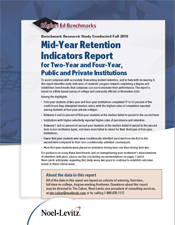student success
6 keys to setting realistic student retention goals and developing a successful student retention strategy

Our latest research report, the Mid-Year Student Retention Indicators Report, showcases some important benchmarks when measuring retention and completion rates. The information can be useful for institutions looking to compare their performance to national standards. But colleges and universities that are looking for specific ways to improve their own retention rates will need to do more than just analyze national trends. They need to set realistic retention goals and develop strategies to reach those goals.
These two processes can be overwhelming for institutions facing significant student losses, or even for campuses looking for small improvements in student retention. However, the following six steps can help guide your institution through the goal-setting process and help you turn those goals into retention strategies that work.
Setting goals
1. Find out your campus’ retention indicators
Looking at trends and data from other institutions can be useful for comparison’s sake, but when figuring out how best to improve retention rates at your campus, it’s crucial that you identify which specific challenges and opportunities are especially pertinent to your students. Set up a side-by-side comparison of the benchmarks in our report and your own trend data to assess your performance and better understand which factors serve as indicators for your retention success.
2. Set goals for the key leading indicators
According to our research, the two leading indicators for retention and completion are persistence and progression. Persistence is a measure of term-to-term enrollment, while progression is defined as successful persistence. Assessing these two factors—along with course completion rates and course success rates, the two leading indicators for progression—will allow your retention committee to set goals that lead to successful improvements in retention and completion rates.
3. Look ahead: Predict retention and graduation rates and their impact on revenue
Take into account the data that you have about your students. Admission information, assessment data, persistence behavior, course completion rates, and success rates are all excellent pieces of information that can pinpoint trends in enrollment and retention. Use these factors to develop correlations that are useful in predicting retention and graduation rates well before IPEDS submissions. Then calculate the impact that improving your retention rate can have on your institution’s revenue. Noel-Levitz offers a Retention Revenue Estimator to help calculate that figure.
Strategy development
1. Make early alert and early intervention a priority
Although most traditional early-alert and early-intervention programs rely on mid-term grades and specific referrals from faculty and staff, they don’t have to. Waiting until the mid-point in the term can prove to be waiting too long, and using data that’s obtained earlier can help predict which students may be candidates for early alert and early intervention. Analyzing historical admissions data against persistence patterns and other first-semester and mid-year assessments will allow your campus to have a clearer idea of which factors accurately predict which students are unlikely to persist. You can use that alert to monitor their progress closely, even before grades or staff members have a chance to raise a red flag.
2. Facilitate academic recovery for struggling students
Academic recovery for struggling students is a critical next step following a successful intervention or early-alert effort. Students who aren’t earning GPAs that meet graduation standards should be required to participate in programs that could include individual counseling, special courses, extended academic support, or a combination of these and other efforts. These programs should be in place immediately following the end of term one.
3. Don’t forget about second-year students
First-year students aren’t the only ones that may be at risk of not persisting. Although they are generally the focus of most retention strategies, our latest report indicates that institutions may also see significant student losses from their second-year populations. Student attrition may also occur between the first and second term of either the first or second year, so monitoring students all the way through the end of their second year can help you improve your institution’s retention rates.